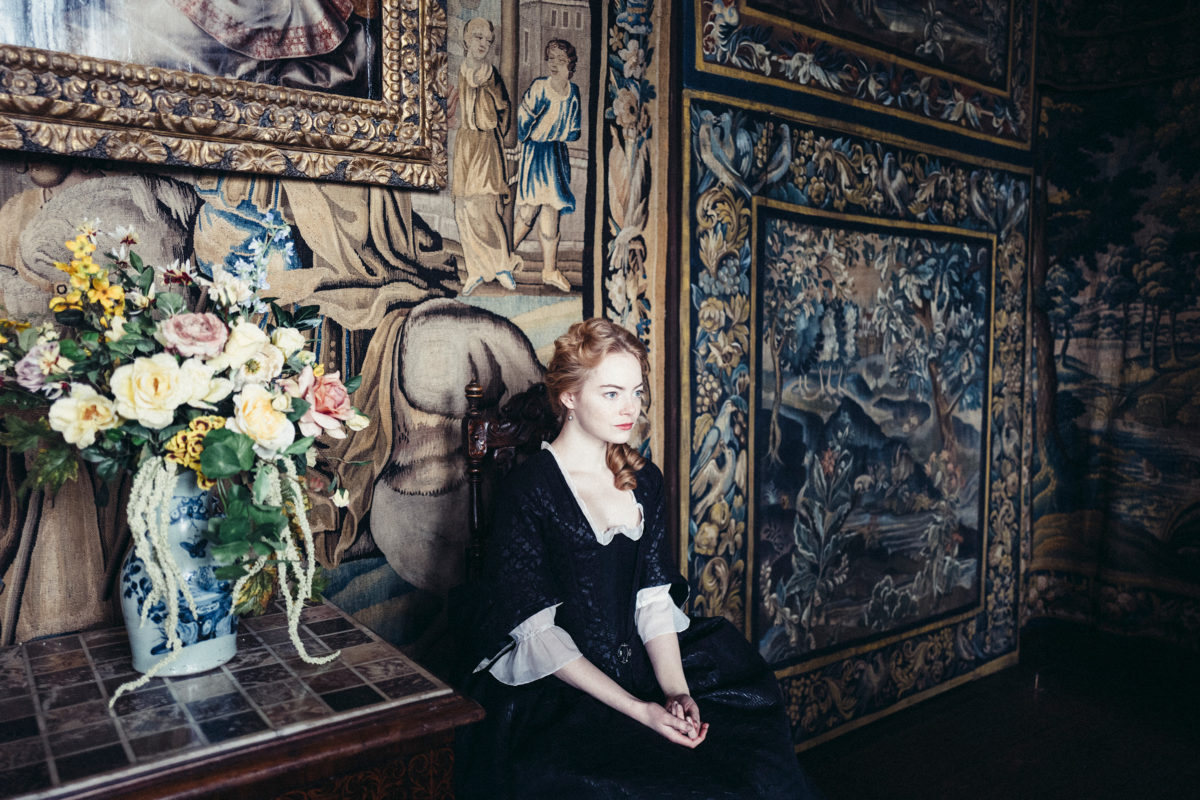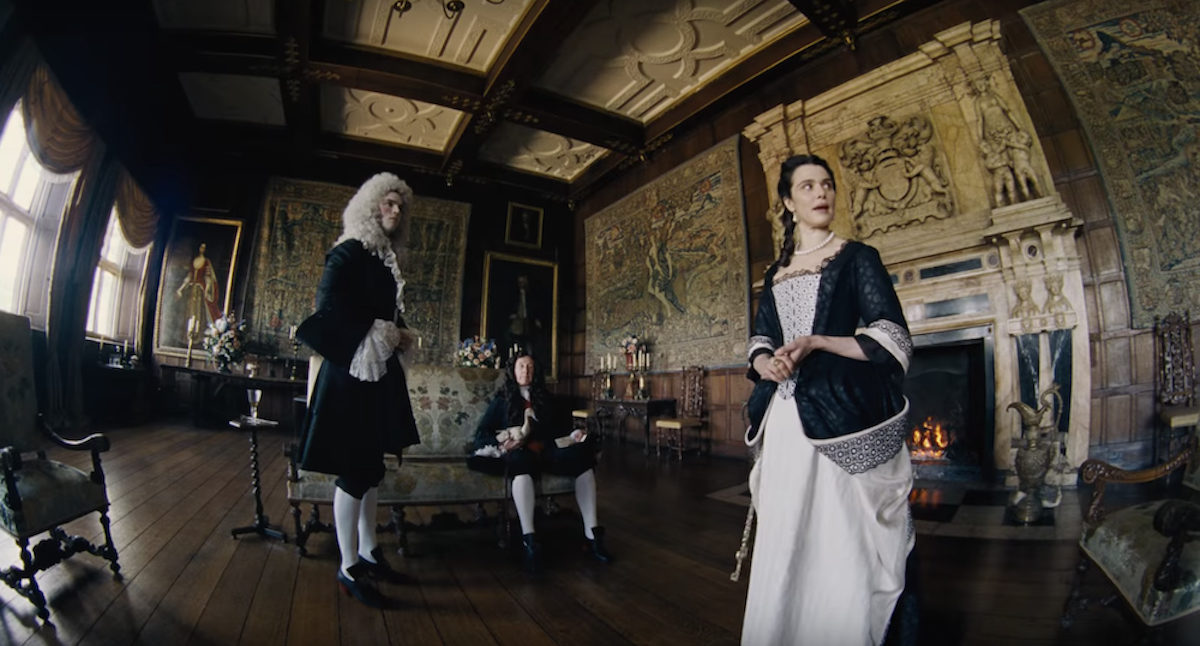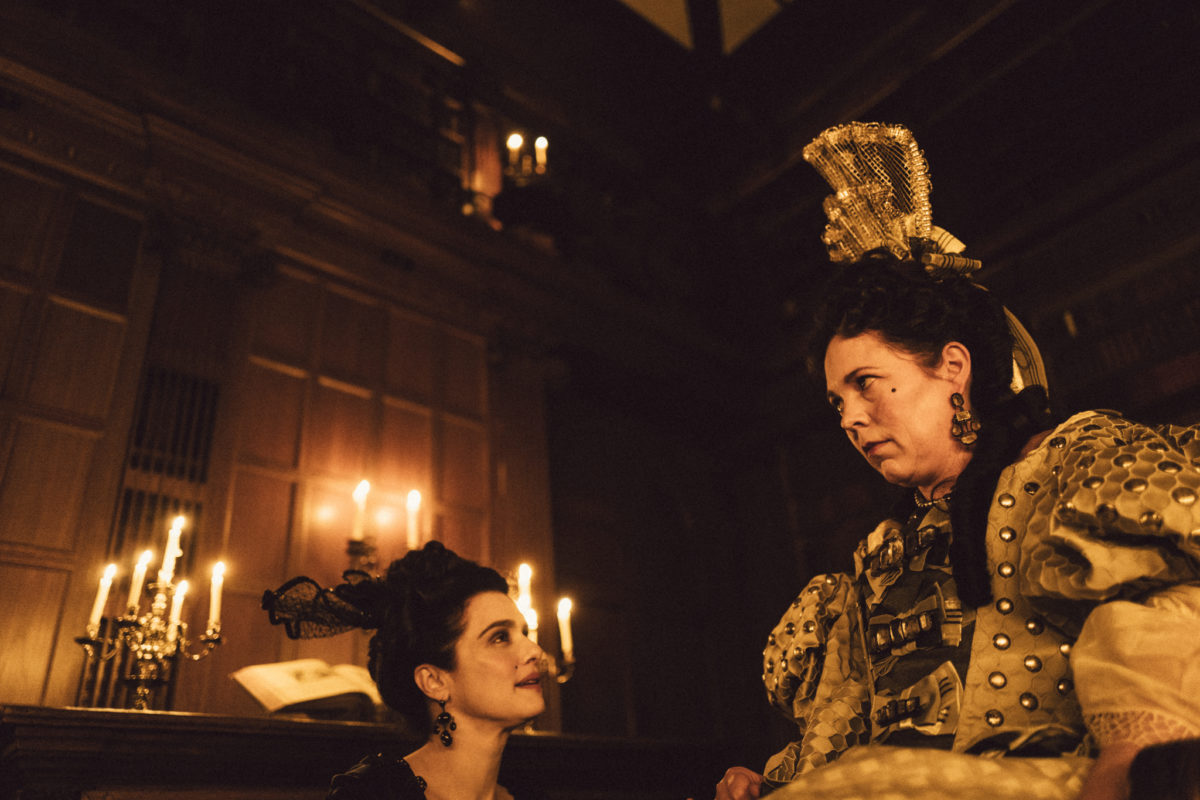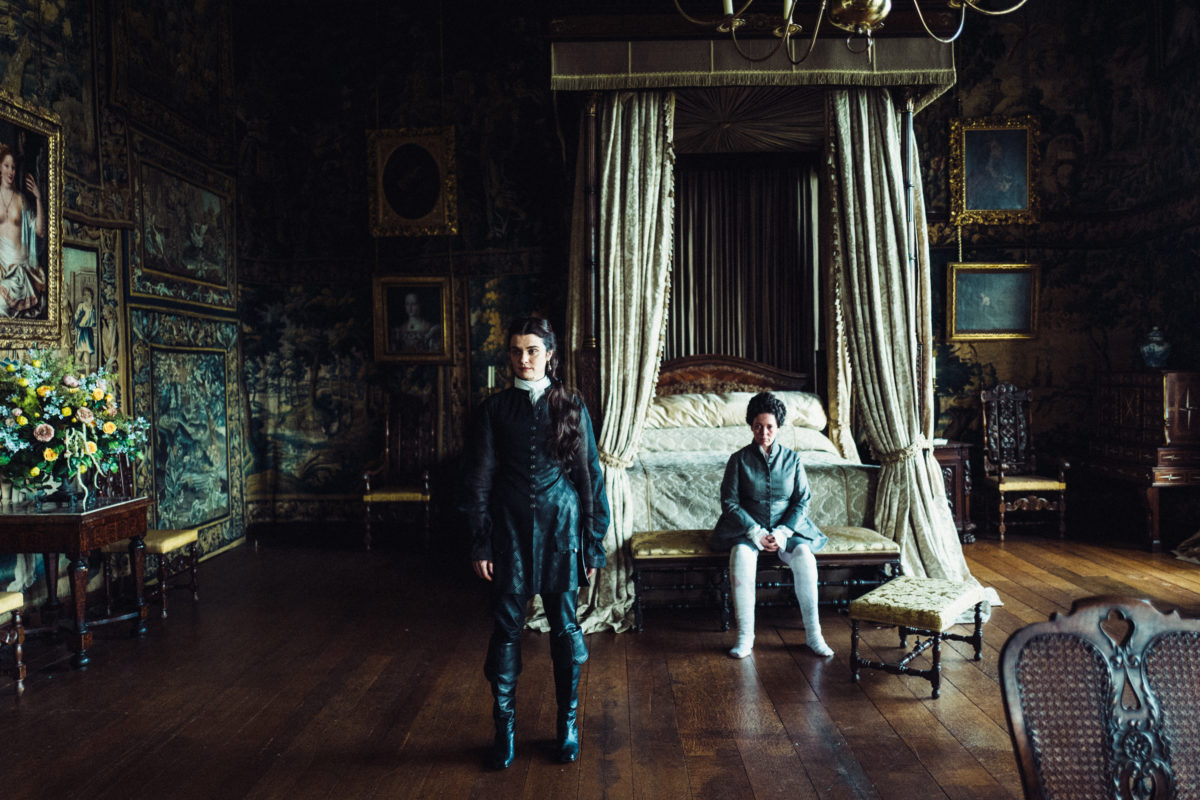Yorgos Lanthimos’ The Favourite (2018) opens with the ceremonial disrobing of Queen Anne (Olivia Colman) of Great Britain, the first ruler of United Britain & Scotland after the Acts of Union took effect in 1707. Appropriately set to the tune of organ music, the scene is first shot from behind, but as the Queen’s posture relaxes with the removal of the royal gown and the crown, it cuts to a medium frontal shot when Her Majesty sighs with relief. Yearning for the comfort of temporarily shrugging off the weighty responsibilities of being queen, is part and parcel of this tragic character.
Throughout the film, Queen Anne is in turn manipulated by her Mistress of the RobesThe Mistress of the Robes is the senior lady in the royal household of the United Kingdom, responsible for the queen’s clothes and jewellery. and childhood friend Lady Sarah Marlborough (Rachel Weisz), her government and, last but not least, her new favourite Abigail (Emma Stone). Anne’s desire to be governed herself — suggesting submissiveness, unfitted for the Head of the Kingdom — delightfully drives this tale of an 18th century all-female love triangle, fuelled by the forces of self-absorption, lust for power, and self-validation active within all three protagonists. These characters and specifically their (and therefore also the actors’) performances are the combustible ingredients of the plot, but the catalytic role of architecture and filmic space, is what makes The Favourite an exquisitely concocted mutation of the period film genre.
In her book on the period film genre, Belén Vidal remarks that the concept of ‘costume films’ accentuates artificiality and the reduction of the past to spectacle. The term ‘period film’, on the other hand, refers to films with a historical setting and somewhat historically relevant mise-en-scene, where:
the past is figured, that is, given visual and narrative entity, and made sense of, through the prism of present stylistic choices, cultural concerns and imaginative (retro-) projections.Belén Vidal, Figuring The Past. Period Film and the Mannerist Aesthetic (Amsterdam University Press, 2012)
In reframing a certain period of the past, one looks back from the critical distance of time elapsed. Seen from a critical distance, the past can seem more static, almost museum-like, and period films which strive for aesthetic authenticity above all, can end up re-creating a ‘bourgeois realism’ of bygone social milieus, or, alternatively, capitalising on a desire for escapism in times of crisis. The period film, thus, has the potential of slipping into either extreme. The Favourite however, takes the middle ground. Its screenplay playfully fills a gap in historical sources, but the solid facts surrounding it are these: Queen Anne was seriously ill and depressed, relied on Lady Sarah for advice and financial guidance (as her appointed Keeper of the Privy PurseThe Keeper of the Privy Purse is responsible for the financial management of the Royal Household.), and the two of them broke off their friendship after Abigail Hill’s acceptance into court. Avoiding the demands of historical accuracy, The Favourite is a period film that represents no ‘real’ past nor tangible present, but a third kind of chronotope, staged as time past but whose language and content seem contemporary and relevant. The Favourite exemplifies a kind of period film that uses both its form and its conceptual content to undermine its own irrelevance to the present of the spectator. Lanthimos’ film flirts with both reality and fiction, exposing a human-all-too-human desire for power, manifested as a sexual one in an institutionalised public space.

I.
Architecture
The Favourite was shot on location at the Jacobean House of Hatfield Estate near London, whose imposing library, spacious armoury, and labyrinthine hallways make an ideal background for the film’s events. The actual house’s horizontal vastness is elevated by an abundance of pilasters, arcades and a staircase, while the plan of the building is spread on two storeys, with a central part and a North and South wing. Hatfield Estate’s interior has been slightly altered, by transforming the Chinese Bedroom into the alluring Queen’s Chambers. Set designer Alice Felton covered its walls with tapestries instead of paintings. By replacing bulky self-indulgent royal portraits with decorative tapestry, the walls of the bedroom seem to resemble a carpeted floor. While as disorienting as it may sound, it makes sense when one considers the Queen suffers from gout, which tethers her to the bed more often than not. By replacing a vertical position (of a standing Queen, or that of a wall), with a horizontal one (of a laying Queen or a floor), the set design proposes a transition between height and length, which is then aroused and vivified by the camerawork.
The larger parts of Hatfield Estate remain unchanged, as the filmic space is mostly confined within the palace and the forest around it. One almost comes to know her way around it, as the characters traverse the same corridors again and again, repeatedly enter the same rooms, every chamber appearing at least twice or for an extended amount of time. Such close acquaintance with the interiors fosters an intimacy that is borderline claustrophobic. Nothing like a moribund castle-turned-tourist-site, The Favourite’s palace is the beating heart of all the events that unfold. More than just a passive backdrop, the walls, floors and windows are “an affair of the senses”, to borrow from Giuliana Bruno, since they “sense, and make sense of, our passing.”Giuliana Bruno, Atlas of Emotion : Journeys in Art, Architecture, and Film (New York: Verso Books, 2002) The palace echoes laughter and screams, and intensifies whispers. The ever-present rooms and corridors bear witness to obvious pleasures (such as a fast wheelchair ride or a duck race) and clandestine delights (sex, blackmail, or conspiracy) alike, absorbing sights and sounds. Their testimony become intimately familiar to the spectator, since only the omniscient viewer knows all that is happening behind their closed doors.
Just like most of its walls are stripped of heavy decoration, the palace’s furniture is far more austere than one would expect for a period drama. Low and slim wooden chairs adorn the few desks in the film. Armchairs are small and compact; nothing would suggest an excessive static lifestyle, except the Queen’s bed, which is the seat of her power and the altar of favouritism. Furniture is pushed up against the walls, freeing up the central space for the character’s wanderings, pursuits, and exploration, almost as if the palace (personified) steps back to become a resonating chamber for their cries of distress, hatred, or pleasure. As it seems, all the household goods are arranged for the Queen’s comfort, and hers only. Her armchairs, her altar-like bed, her sofas — these are the gathering points around which this power-centric society is structured, as the Court meetings take place wherever the Queen reposes.

II.
Cinematography
Cinematographer Robby Ryan (known for his work with Andrea Arnold on Wuthering Heights [2011] and American Honey [2016]) masterfully animates the filmic space, playing with dynamic oppositions in the 1.85:1 ratio: high-low, distant-close. The Favourite is characterized by an abundance of tracking shots, pans, warped wide-angle shots, and slow motion, either accelerating or arresting movement while also navigating intimacy. The interior space is orchestrated as vast and compressed at the same time, a systolic-diastolic beating heart of sexual desire. The opening sequence of the film affirms this conjugation between proximity and distance in its cinematography by avoiding the classical linear syntax of long shot, medium shot, close up, its oscillation producing an erotic tension. Alternating between long shots and close ups, the camera acquaints the viewer intimately with its subjects. The use of space within the frame reflects the passage from loneliness to intimacy that the characters experience, shared by the spectator by virtue of the camera. Ryan’s use of close-ups challenges their underlying psychological opacity.
Throughout the film, close-ups are usually part of long takes, as a static camera lingers on a character’s face. When Abigail discovers that Lady Sarah is even more intimate with the Queen than her role as Groom of the StoolThe Groom of the Stool was the most intimate of an English monarch’s courtiers, responsible for assisting the queen in excretion and ablution. The physical intimacy of the role naturally led to her becoming a woman in whom much confidence was placed by her royal master and with whom many royal secrets were shared as a matter of course. This secret information — while it would never have been revealed, to the discredit of her honour — in turn led to her becoming feared and respected and therefore powerful within the royal court in her own right. suggests, her facial reactions reveal the lovers clandestine delights, rather than showing them in the act. Framed by darkness, which hides her from the women, Abigail’s face is lit and the focus on her widening eyes and twitching muscles reveals nuances of surprise, shock, fright, and ultimately, voyeuristic pleasure. This array of emotions, as newly acquired knowledge, governs Abigail’s plan to seduce the Queen from this moment on. In this moment of realisation, the camera keeps insistently static, as Abigail and the spectator are bound by the shared secret. The closing sequence of the film frames Abigail’s face in a similar manner, but this time she is kneeling down to the Queen, massaging her leg (which proves to be an allegorical reference to sex in the film), her hair violently grabbed by the Queen. The camera insists on being still, emphasising Abigail’s defeat and humiliation. This time, her face does not reveal nuances of shock and pleasure, since her gaze does not face the audience. Her descent into pain and shame triggers the following shot, a double-exposure of Queen Anne and Abigail’s faces, avoiding each other’s looks. The frame slowly fades into a shot of the 17 rabbits Queen Anne keeps to commemorate her 17 deceased children. A metaphor for Her Majesty’s unresolved trauma of infertility, the rabbits populate the set of The Favourite as a totem, a reminiscence of a past that cannot be forgotten.

III.
Sexuality
Queen Anne’s court is the embodiment of desire; its body parts are the rooms and corridors of the palace, brought to life by means of cinematography. The interplay between domination and submission in the love triangle is what keeps its blood pumping. Firstly, food here serves a purpose different from satisfying a basic need. The characters have a dysfunctional relationship with food, and no one is enjoying a proper meal. The only time when a dinner table is shown, is when a party has gone nuts, its guests drunken and deranged. Otherwise, the act of eating is substituted by munching, snatching from plates, binge-eating, and throwing food at other people (bombarding a naked man with pomegranates, for sport). Transforming food into entertainment or a substitute for emotional nourishment is a means of sublimation. In this feast-or-famine attempt to fill a void of grief, the Queen eats a whole cake, and pukes it all out, only to start devouring another piece — an analogy for her mistreatment of feelings: they always seem to creep up, similarly to the need to throw up. A parallel can be drawn between Lanthimos’ depiction of Queen Anne and Sofia Coppola’s portrayal of Marie Antoinette in her eponymous 2006 film. In both films, the eccentricities of a lonely protagonist resonate in the set’s architecture. Both queens are unable to bear children — a trauma on a personal but also monarchic level, as they cannot produce an heir. Subsequently, both of them are shown to overly consume food in compensation.
In addition, Queen Anne’s disdain for dance and music reveals her aversion towards facing her own trauma, and succumbing to the weakening feeling of loss. By withholding her grief in such physically apparent rejections, Queen Anne’s character sinks deep into tragedy. Her severe case of gout disables her walking, and numerous sequences revolve around her cries of pain and helplessness before the illness. Gout transforms her body, the battlefield over which Sarah and Abigail contest, exemplifying the kingdom in a state of war under a weak ruler. In its swollenness, sickness, faultiness, however, it remains a desired, sexual object. The allure of authority, of the fact that it is not just any body, it is the Queen’s body, sexualises her bloated, inflamed figure.
As for the pleasures of the flesh, The Favourite eschews sex scenes, yet the sexual undertones are apparent in the language. Threats of stripping and whipping pierce the air; both Sarah’s and Abigail’s flirtations touch on violence. Every slap is passionately arousing, sexually explicit repartee not rare: the royal household seems to be obsessed with the ‘c’-word (which is not ‘court’). A film with women far outnumbering men, The Favourite neutralises the male gaze, presenting men as superficial slithery creatures, who can only plot against the ruler, or are just man-toys to powerful women. When Abigail’s admirer, Lord Masham, enters her abode at night, she interrogates him: “Are you here to seduce me or rape me?” As he affirms that he is a gentleman, Abigail plays dead and confronts him: “So, rape then”. The notion of immobilising men’s predatory behaviour may fuel some #MeToo discussions, but Lanthimos handles the situation with great humour, rubbing a pinch of salt in both sides’ wounds.
Lanthimos is a master of constructing rigid, hermetic social structures: be it family (Dogtooth [2009], Killing of a Sacred Deer [2017]), or community (Alps [2011], The Lobster [2015]). By tying his characters to extremes of moral judgement, social restriction (such as family values), or institutional order (e.g. ‘The Hotel’ in The Lobster), Lanthimos lets them dwell in a transgressive limbo, between grotesque and caricature, suggesting human nature is a weave of fine and crude textures. In The Favourite, the Queen’s palace functions as an extended household — linking it to the ‘family’ strand in Lanthimos’ oeuvre —, while in as much as it remains an institution, an example of a hierarchized society, it is also an instance of Lanthimos’ constructions of an ‘institutional’ social order. In its hybrid nature, The Favourite is tangibly more intimate than Lanthimos’ previous work. The allure of sexuality is free-flowing as in a game, playing hide-and-seek in compressed corridors, yet has its traumatic undertones in impotence. The ferocious fight for power at the heart of the film is a fight for the powerless Queen. In its violent iterations, desire is exemplified by whipping, strangling, blackmailing; each action reconfiguring the power-dynamics in the film. As the architecture of the set, and the animated tensions within the cinematography weave an attractive and inclusive structure of desire, The Favourite subjugates the public sphere of court life to the private. In this subverted hierarchy, its characters are flesh and blood, defined by their inner power-dynamic, and ultimately, as the curtain falls, consumed by the hunger of desire.
